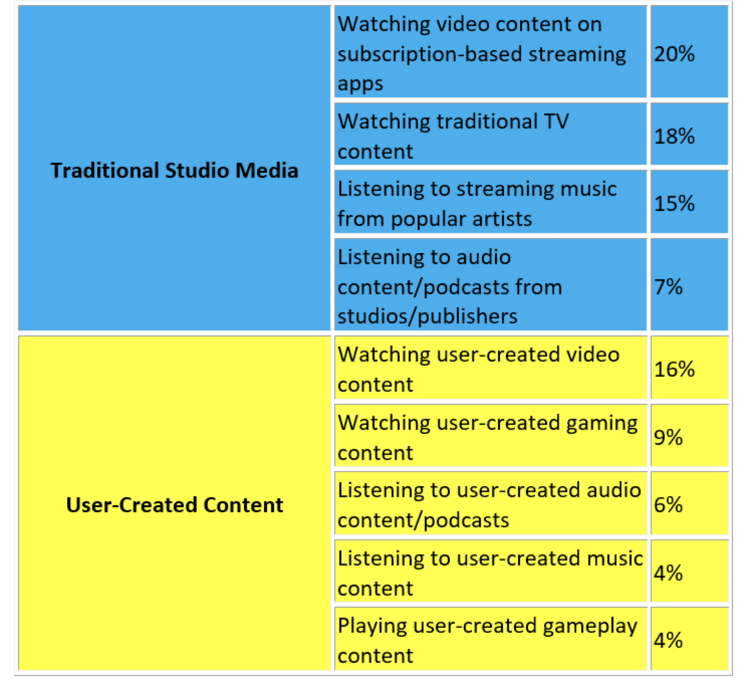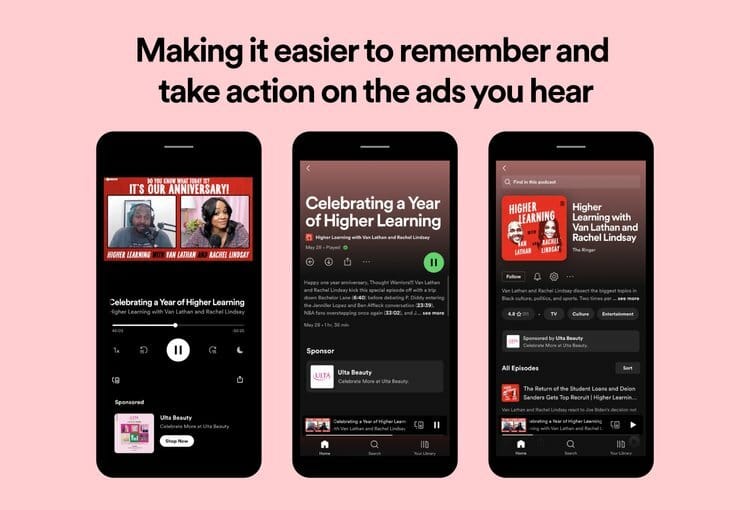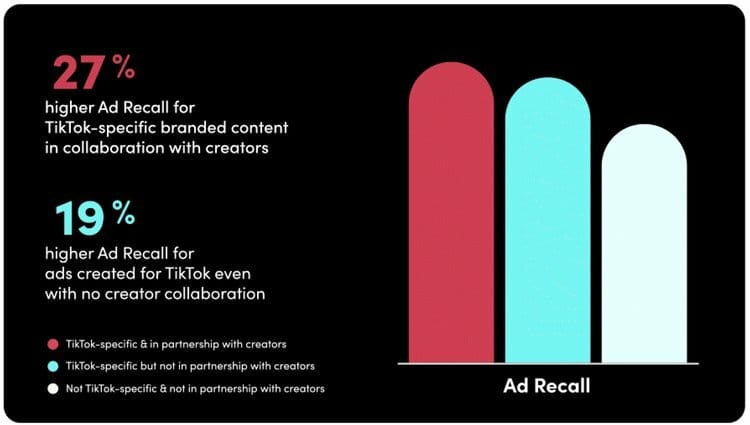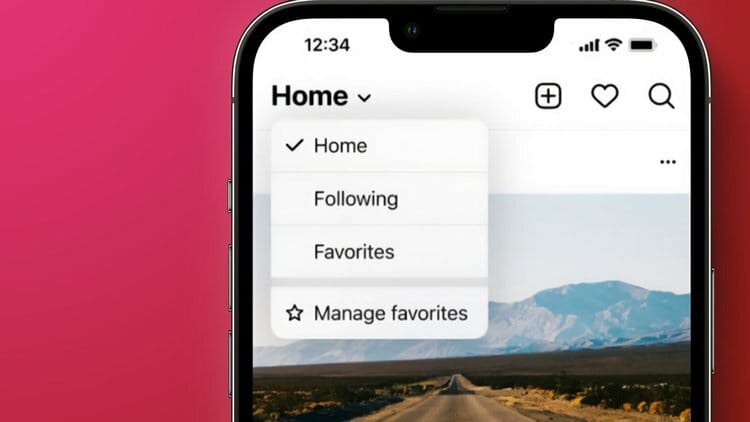Happy Friday! After the holidays, it has been nice to get back into the groove, but I am looking forward to a long weekend filled with playoff football. I hope you enjoy today’s newsletter and have a wonderful MLK weekend.
Today’s Edition:
Consumers are spending nearly as much time on user-generated content as traditional media
Pinterest makes it easier to discover creators in search
Spotify launches a first-of-its-kind interactive ad format for podcasts.
Consumers Now Spend 39% Of Their Media Consumption On User-Generated Content

Consumer Technology Associate (CTA) reports Americans spend 39% of their time consuming user-generated content like TikTok, Instagram, YouTube, and podcasts, compared to 61% for traditional studio media.
When it comes to video content specifically, Americans spend 16% of their time on user-created video content and 18% watching traditional TV content.
The data comes from the trade association's Exploring the Creator Economy study in conjunction with YouGov, which was designed to understand U.S. consumer attitudes and behavior as they relate to online user-generated content. More than 2,000 consumers ages 13 and over with mobile devices were surveyed.
In the wake of a pandemic, user-generated content has grown with more people turning to their favorite creators to learn, be inspired, and be entertained. Americans still spend most of their time with traditional media, but UGC is catching up.
For some demographics, UGC is currently being consumed more. Teens (ages 13 - 17) are currently spending 56% of their time on UGC already, compared to just 22% for consumers 55 and older.
With more people realizing their potential as creators and the increasing relevance and impact of social media platforms, the current gap between UGC and traditional media will likely close even more.
In the next few years, there will be an abundance of creator-led content as creators turn their interests into businesses and side gigs. In addition, companies will continue to lean on creators for their content needs as a way to reach consumers, who are increasingly attracted to UGC.
In particular, TikTok has shown how powerful and influential user-generated content can be. Thanks to its endless supply of entertaining, inspiring, and educational content, TikTok became the most visited website in 2021. In addition, TikTok launched a new partnership with Atmosphere, which will bring its videos to the television screens of more than 19,000 commercial venues.
If things continue along the current trajectory, there will be a day when Americans’ primary source for media centers around creators.
Pinterest Enhances Creator Discovery With New ‘Profiles’ Tab In Search

With a new update to its search feature, Pinterest is making it easier to find creators.
A new Profiles tab within search lets users discover creators by their names or by the type of products and content they share.
From the Profiles tab, users can enter a creator's name, keywords, or product type, and a list of relevant creators will appear. For instance, if you search for "New England travel," you will see a list of creators whose bios or captions contain these keywords.
By providing additional ways for users to discover creators, Profiles enhances the discovery of creators.
This is useful not only for Pinners who want to find creators based on the type of content they are interested in, but also for brands who want to partner with creators within a specific niche. Plus, creators benefit from increased discovery potential and exposure, which can help them gain new followers or secure a branded content deal.
Profiles is part of a larger trend of social media platforms rolling out new ways for users to discover more creators and content, while also helping creators get in front of the right audiences.
Pinterest also boosted its creator discovery capabilities this past fall with the launch of Watch, a full-screen, vertical feed that mimics TikTok's For You feed. Consisting of Idea Pins, the platform’s Stories meets short-form video feature, Watch has been instrumental in helping Pinners reach new audiences.
Consider leveraging the new search experience if you are looking for new creators to be inspired by or sourcing creators within a niche for your influencer marketing campaign.
Spotify Brings Interactive Ads To Podcasts

In 2019, Spotify announced its intent to expand its podcasting capabilities. The streaming service has since invested in enhancing the podcast experience for users through video podcasts, Q&As, polls, and more.
Now, Spotify is adding Call-to-Action Cards. Powered by its streaming and insertion technology, CTA Cards are a new kind of ad format. They appear in the app when podcast ads begin to play and later when users are browsing the app.
CTA Cards feature eye-catching visuals, customizable text, and clickable buttons. When the listener clicks the button, they are directed to a relevant campaign landing page such as a product page.
Advertisements are a common practice for podcasts, typically in the form of 15-30 second ads read by hosts. Because people are typically multi-tasking while they listen to podcasts, the impact of these ads may be lost as listeners easily forget the URL or promo code that the host shared.
Now that there is a clickable call-to-action, listeners can take action in-app. That action can be taken immediately while they listen or later while they browse.
The format has already proven to be effective with tests driving twice as many site visits as non-clickable podcast ads.
With the launch of CTA Cards, Spotify podcasts are now more interactive, as listeners will have the opportunity to easily take action on advertisements that catch their interest.
It also offers more efficient measurement for podcast advertising by tracking campaign-level impressions and insights, which will help advertisers understand the impact of their campaigns.
The ad format is currently only available to Spotify Original and Exclusive podcasts. When it becomes more widely available, it can help accelerate the adoption of podcasts as an influencer marketing channel, since creators will be able to better prove the ROI for brand sponsorships.
The podcasting advertising business is on pace to exceed an estimated $2 billion by 2023.
Quick Hits
TikTok released a new research study highlighting the effectiveness of creator-led content. According to the study, the Ad Recall of TikTok-specific branded content is 27% higher than non-specific TikTok content that isn't in partnership with creators. Additionally, the study found that 62% of consumers agree that sponsored content, posted by creators on behalf of brands, is the best way to connect with them.
As TikTok's study shows, the most effective way for brands to reach and engage consumers with ads is through creators and content that is native to the platform. Combining these two factors can create more powerful ads that can boost video view rates, reinforce brand recognition, and increase ad recall. The majority of marketers, especially those operating in the influencer space, already know the benefits of working with creators to design tailored content, but now it is also backed up by data. If you're looking to reach consumers on TikTok, be sure that creators are part of the strategy in order to maximize campaigns' effectiveness. Like TikTok says, Don't Make Ads, Make TikToks.

Instagram has begun testing new feed options, including the highly-requested chronological feed. Soon, users will be able to choose between three different feed experiences: Home, Favorites, and Following. Home is today's current feed, where content is surfaced to users based on their interests. Favorites display content from accounts that users have selected. Lastly. Following is Instagram’s original feed that displays posts from those accounts users are following chronologically.
Instagram users have pleaded for a return to the chronological feed for years. Although they will have to select Following each time they open the app for the chronological feed experience, the update should be sufficient for users who expressed the desire to see content from people they are following based on when they post. Instagram will not be the last social media platform to give users more options and control over the content they see.

Twitter has launched a test of Tweet Takes. The feature allows users to respond and react to Tweets visually, allowing them to respond with a photo, video, and a Tweet embedded for context, similar to TikTok's Video Replies, Instagram's Reels Remix, and Pinterest's Takes.
New product updates were a big part of Twitter's year in 2021. This year will likely be no different, based on the release of Tweet Takes. By using this feature, platform users can participate in conversations and provide more visual commentary. As seen with TikTok's Video Replies feature, there is a whole world of content consisting of creators sharing their reactions to the content shared by other users.

Linkedin launched LinkedIn Audio Events. It’s a Clubhouse-like feature that enables people to connect through casual live conversations in their communities.
Not enough is being said about what LinkedIn has done in the last few months. The platform is slowly shifting the perception that it's just a place for job-seeking, networking, and business thought-leadership and encouraging more people to use it for a range of use cases, including content creation beyond business topics. Audio Events joins a growing list of tools that creators can utilize to drive conversation, engage their audience, and expand their reach on LinkedIn.

Clubhouse introduced new ways to discover and consume content with Sharing and Web Listening. Users can share Clubhouse rooms they are listening to with followers and across other social media apps through the former, while Web Listening allows anyone to listen to rooms without installing an app or logging in.
Clubhouse use has declined dramatically, but the app continues to make valuable updates. In the last few months, the social audio app has delivered a number of highly-requested features, such as room recording and playback, enhanced discovery, and link sharing. With a number of competitors in the social audio space, and with most people not confined to their homes due to the pandemic, Clubhouse probably won't ever get the attention it did last winter, but it still fills a niche.

What I’m Reading
Cameo poised for bigger role in brands' 2022 social strategy (Marketing Dive)
Direct-to-consumer brands dip their toes in the world of NFTs (ThingTesting)
The best company TikToks are unhinged — and it’s working (Protocol)
Meet the ‘Influpreneurs’: The new breed of YouTube influencers staffing up and building business empires (GQ)
Social commerce to grow 3 times as fast as e-commerce, Accenture predicts (Retail Dive)
